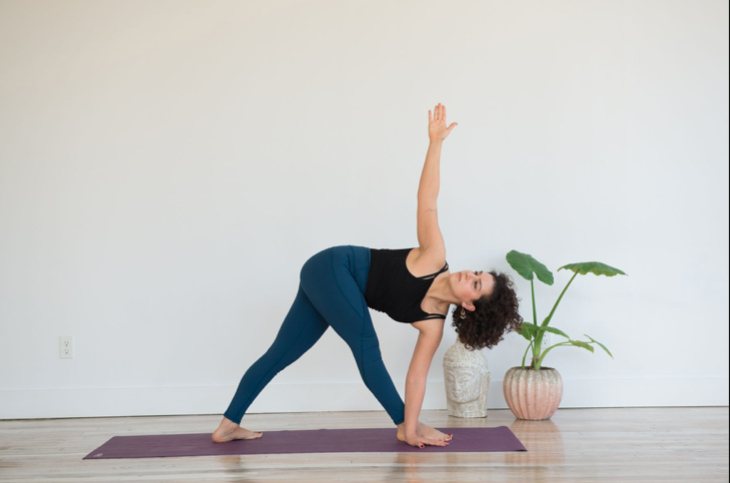Do you sit at your desk for long hours everyday? do you experience back pain?
Then you gotta try Revolved Triangle Pose or Parivrtta Trikonasana.
Parivrtta means to turn around/revolve/back + Trikon means Triangle.
It is a powerful and challenging pose which requires a lot of concentration and attention to some parts of our body that we may not be aware of. So if your mind wanders, this is a great pose for you because it enables you to practice “ekagrata” which means to pay close and undisturbed attention or having one pointed focus.
How to do the pose:
Start in Tadasana/mountain pose. Have two blocks on top of the mat and place your right foot forward between the blocks at a 90 degree angle and left foot back at 45. Your feet are heel to heel alignment and they are 4 to 5 feet apart (depending on your height and balance) If you feel you might lose your balance have a shorter stance. Keep your legs straight and on your inhale take your arms up and lengthen the spine, then take your right hip back and left hip forward, on your exhale take your arms forward and down to place them on the blocks, on the way down make sure you maintain the length in the spine. Keep your legs strong, straight and engaged. Anchor the outer edge of your back/left foot. Bring your right hand to your sacrum and lower back area to keep your hips level. The tendency is to sometimes twist from where it is easy, which can be the lumbar (lower back) or cervical spine (upper back and neck) and not to twist from where it is not easy and that's our thoracic spine.
Take your right hip back and left hip forward and twist through your thoracic spine/middle back. Open the chest to the right and the last piece is to take your right arm up.
There are a few options for your left hand:
You can keep it on the block on the left side of your right foot or i
If you have a good balance, place your left hand on your shin bone or on the ankle
You can have your left hand on the right block (adjust the height of the block if you need to)
For the final variation, you will place you left hand on the mat, on the right side of your right foot.
You also want to keep your arms straight and engaged in line with each other.
Now let's pay attention to your neck and focal gaze. If you experience neck pain, tuck the chin in and keep your neck in line with your spine, look to the floor or to the side, if you are not experiencing any pain, you can gaze at your right thumb.
Paying attention to your breath is very important, you can inhale to lengthen the spine to create more space among vertebras, exhale and twist more. Hold it for 5 deep breaths and then switch sides.
What are the benefits of this pose?
It increases your concentration
It strengthens your arms, spine, legs, ankles and hip muscles
It teaches you to twist from your middle back
It facilitates the movement of your abdominal muscles hence it helps with digestion
It increases flexibility of hamstrings, calves and the spine
It broadens the chest fully, presses your shoulders back, hence you will have enough space in your diaphragm to breath while you are twisting
It relieves pain in the back
Precautions:
You should modify it if you have a bulging or herniated disc, have issues with your SIJoint or if you are pregnant.
In any above case, you can have your bottom hand on two blocks stacked on top of each other to decrease the twist or you can have the same hand to the wall or on a chair.
Its very important not to over twist the neck and thats why you want to get connected to your middle back to revolve from there.








